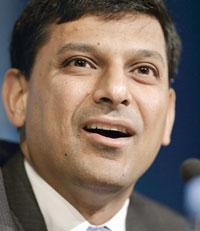The new chief economic adviser represents an important economic gambit

For dummies, and those who just landed from the moon, Indiahas a new chief economic adviser (CEA). This is a job held by the likes of IGPatel, Shankar Acharya and Deepak Nayyar, not to mention Prime Minister ManmohanSingh himself. His name is Raghuram Rajan. He’s an IIT-ian who then went toIIM-A and then into heavy-duty economics. The journey included a professorshipat Chicago’s Booth School and the job of Economic Counsellor (popularly: ChiefEconomist) of the International Monetary Fund (IMF).
In between, in end 2005, this entailed an intervention atJackson Hole, where the world first heard the words, “we should be prepared forthe low probability but highly costly downturn”.
The prescience was ignored, something (as noted by theEconomist) IMF graciously conceded in the following words: “Despite theimportance of the Economic Counsellor's position, there was no follow-up onRajan's analysis and concerns— his views did not influence the IMF's workprogram or even the flagship documents issued after the Jackson Hole speech.”
Now, the cool thing about our new CEA is that he’s not even50 and looks even younger! His book, 'Faultlines: How Hidden Fractures StillThreaten the World Economy', was the best business book on FT and Goldman Sachslists for 2010. One can almost see the business channels relishing at thisheady cocktail of economics and sound bites. Ditto for business journalsinterspersing lovely pictures with the cheekiest of quotes.
So, pro bono advice: stay away from television. This isIndia. The path between broadcast trucks landing at the convenience of yourhome and utter disaster is really very, very fine.
That said, here’s the context. There are too many economictalkers in this government already. From Montek Ahluwalia to C Rangarajan toAnand Sharma, not to mention P Chidambaram himself. Each one finds the bouquetof sound-bite soldier’s gun mikes far too irresistible. Each time they’reambushed, they say the same thing again. Yawn!
This was equally true of the President of the Union while hewas FM. Result? Each of these utterances, often unintentionally, have confusedthe market thoroughly. Do we need the CEA to add to a discredited cacophony?
Holding back a star player wouldn’t be easy. But six monthscould be valuable time for Rajan to transit from his professor’s perch atChicago or shed the Canali suits (disclaimer: I have no knowledge of thespecific brand that Prof Rajan likes) of the IMF days!
This would also be a valuable time to deep dive andintegrate into off-the-record conversations with India’s bureaucrats andministers, described by Rajan himself in his convocation speech at the IndianSchool of Business this year as, "sui generis in their articulation of theIndian reality, deeply conscious of keeping the diaspora, the states and theprivate sector away, for reasons in part measure out of intellectual lazinessand partly self serving."
Such truth is best articulated while you’re speaking from33,000 feet. This is terra firma. This is about working with an opiniatedminister like Chidambaram, who despite being only the line minister and thefact that Rajan has been (and continues to be?) an honorary advisor to the PM,would like to hear the best ideas first, not trial balloons on CNBC or NDTVProfit, or even the Financial Times of the Wall Street Journal.
Incidentally, being the source of bright ideas is theunwritten job that makes or unmakes a CEA. Manmohan Singh, himself, earned hisspurs with then Prime Minister Indira Gandhi when she was pitted against theJayaprakash Narayan war cry against inflation. There’s a honey moon period todo that. If Rajan misses that, as some would argue Rakesh Mohan an earlierincumbent did, or as Kaushik Basu the immediate predecessor did, failing to getpast Amita Paul, gatekeeper to Pranab Mukherji’s inbox, all that’s then left todo is to write the annual Economic Survey. It’s a document that says all theright things ailing the economy, but it’s 3-minutes of fame is overshadowed bythe Union Budget. Even here, the CEA is traditionally the author of the firstdraft of what the FM actually reads out, and finance ministers like Chidambaramand Mukherji are known to have sidelined their CEA once too often.
Which brings me to the point about why Raghuram Rajan is soimportant for the Indian system. His is the first and foremost, a voice ofreason and credibility among Global Inc. stakeholders. He represents the returnof a true-blue international econocrat (Kaushik Basu didn’t work outsideacademia). It’s a rich culture that we’ve squandered over the years, a far cryfrom the days that working in government attracted prodigious talents such asBimal Jalan, Shankar Acharya, Parthsarthy Shome, Rakesh Mohan and Montekhimself.
So, if he plays his cards well, if he listens a lot beforehe speaks, Rajan’s presence can truly benefit India’s sagging fortunes.
The TV anchormen will jump in joy, but thereafter Rajan willbe written off as one more failed import.
Even more important than being CEA is where Rajan could beheaded next. The story goes that in 2008 when the search was on for a governorof India’s Reserve Bank of India (RBI) to replace YV Reddy, Manmohan Singh, aformer guv himself, received a pressing recommendation from Montek. That manwas Rajan. Manmohan was impressed, but he thought against someone who hasn’tworked in India. So, he let authorized an offer for Deputy Governor, a positionRajan politely passed over. It is Montek who then found a compromise in lettingRajan be an advisor to PM, albeit concurrent with his raft of academicresponsibilities. Somethings Rajan must have said must have stuck, which iswhat explains his accession to the CEA’s job.
Governor Duvurri Subba Rao retires from the RBI on September4, 2013, after a long extension. That could be the day for Raghuram Rajan, theyoungest ever in the central bank’s history.
Unless, of course, the Indian neta-babu mafia has got thebetter of him by then. If it has, Rajan might only have himself to blame! Hecould even blame the IMF. Nothing in the Chief Economist’s job there preparesyou for the heat and dust of New Delhi’s Bhawans and the minefields calledregulation and governance.